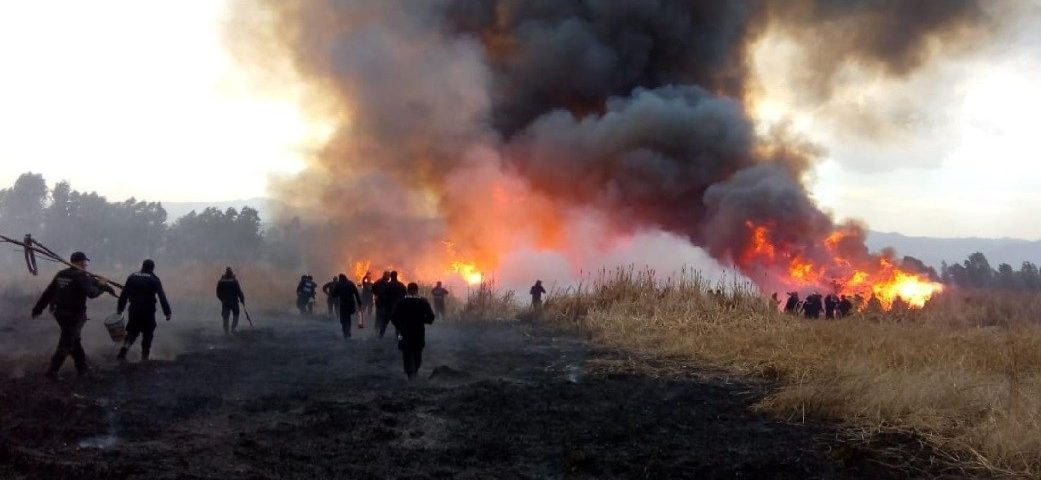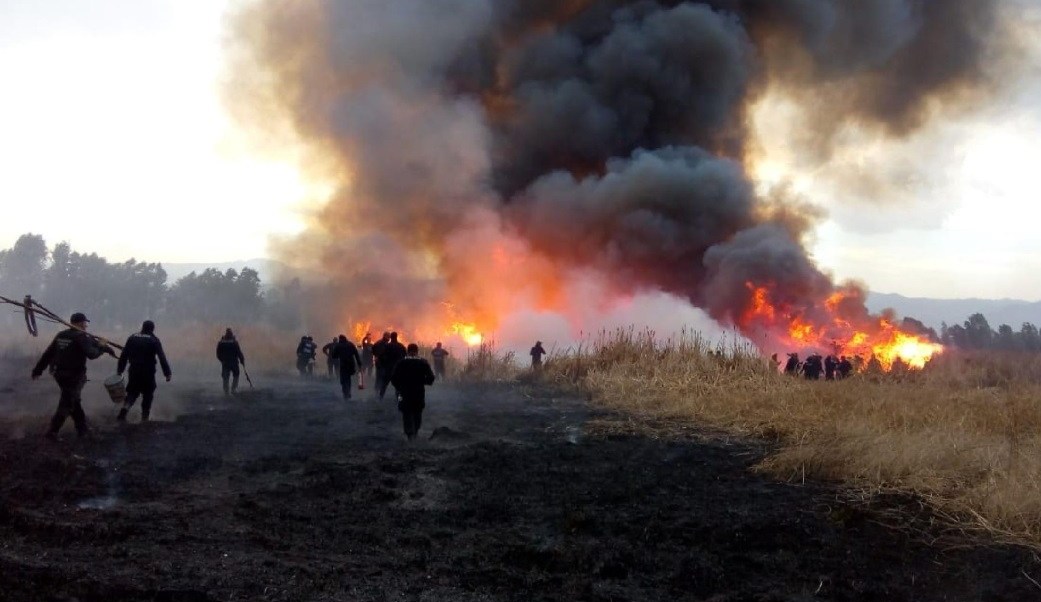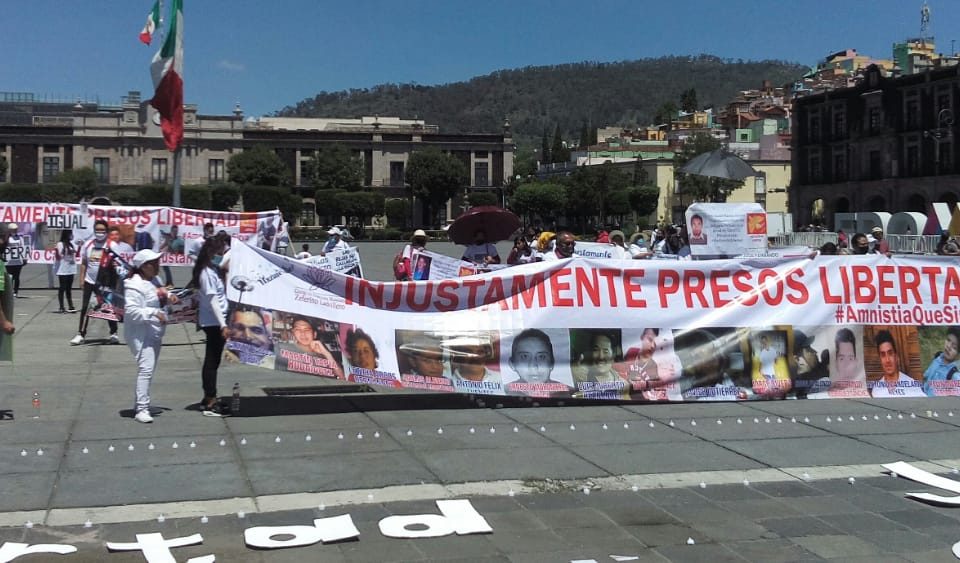
There will be discounted parties and independents, the cost of repainting walls
May 14, 2019
Groups enrich disappearance law, there are more than six thousand people missing
May 14, 2019Bulletin No. 15/19 OCCA: Fires show insufficiency in the reaction capacity of authorities and reveal historical lags to improve air quality

HIGHLIGHTS
Bulletin No. 15/19 OCCA: Fires show insufficiency in the reaction capacity of authorities and reveal historical lags to improve air quality

May 14th, 2019
As a result of the air quality crisis reported in city halls and municipalities of the Metropolitan Zone of the Valley of Mexico (ZMVM), the Citizen Observatory of Air Quality (OCCA) expresses its demand to take the appropriate measures to short, medium and long term to guarantee the right to health and a healthy environment.
According to the local and federal authorities, the poor quality of the air breathed by the inhabitants of the ZMVM today is due to the various fires in the region, high temperatures, lack of wind and rains. Given these statements from the OCCA we believe it is important to note that the serious problem of fires is an increasingly common phenomenon at this time of year, therefore, the problem that afflicts us today is not so casuistic or exceptional as has been stated so far. Forest fires are, unfortunately, a problem that will increase in the face of climate variability scenarios derived from global warming. Given this scenario, not having an action protocol for high concentrations of PM 2.5 is a serious omission on the part of local and federal authorities, but it is also a systematic violation of the right of all Mexicans to health and a healthy environment. Therefore, we call for the strengthening of the local capacities of emergency bodies for the containment of fires.
Addressing the problem of air quality in isolation from climate change will not provide effective solutions since both mitigation and adaptation actions are required. Likewise, the OCCA considers it important to take consistent measures beyond the emergency situation that serve to reduce pollution in the medium and long term, in particular the emissions generated by the transport sector that is the largest consumer of fossil fuels with more than 60 % of the City's energy, and therefore it is related to the highest emissions of particles (PM10 and PM2.5), nitrogen oxides (ozone precursors) and carbon dioxide according to what is indicated in the Inventory of Emissions from Mexico City (CDMX) [1]. Situation that has origin in obsolete norms of control of emissions as much of the light transport as of the transport of load, and to the lag of more than 10 years that has PEMEX, and now the private ones also, to distribute in all the country the diesel of ultra low sulfur (DUBA).
Only In 2017, contamination by fine and ultrafine particulate material (PM10 and PM2.5) derived from land transport caused 4,009 deaths in the Metropolitan Area of the Valley of Mexico, equivalent to 2.21% of its Gross Domestic Product (GDP). [2] ] In contrast, the environmental contingency phase in the CDMX is only declared when exceeding 150 IMECA points, that is to say, reaching an average concentration of 97 μg / m3 in 24 hours per PM10, [3] leaving PM 2.5 out of the Program of Environmental Contingencies. The World Health Organization (WHO) for its part recommends that this concentration does not exceed 45 μg / m3. That is, in Mexico we must exceed more than double (57 μg / m3) of the limits indicated by WHO to declare a contingency for poor air quality, without considering that the measures adopted afterwards are appropriate for the population .
The OCCA noted the need to regulate all sources that emit volatile organic compounds (VOCs), which end up becoming ozone at the surface level, and other priority pollutants such as fine particulate matter. These result in a direct impact on the health of people, and particularly in the vulnerable population such as people with respiratory disease, children and elderly, increasing the prevalence of obesity and overweight, asthma, acute respiratory infections, bronchitis , chronic obstructive pulmonary disease (COPD) and cancer. According to the National Institute of Respiratory Diseases (INER), COPD in Mexico is located between the 6th and 4th place of mortality. [4]
The Secretariat of the Environment of the CDMX reports that private vehicles are the largest emitters of VOC, derived from the large number of units that circulate in the city in 2016 were 2.3 million vehicles.
Therefore, the OCCA indicated that it is urgent that the Environmental Contingencies Program (PCAA) be modified to include the following immediate actions:
Apply today does not circulate holograms 1 and 2 and for cargo transport, both in Mexico City and in the State of Mexico; Time restriction of freight transport; Reduce to 40% industrial activities that generate particulate material; Reduce to 40% construction activities that generate particulate material; Maintain gas measurement and OBD in verification; Launch a social communication campaign to alert the population about the risks of poor air quality in their health and give information to get involved in the solution.
In turn, the OCCA encourages the authorities to commit to consolidate a policy of air quality in the short, medium and long term, based on congruent measures such as: Incorporate the contaminant criteria PM2.5 into the PCAA; Strengthen the PCCA Exemption protocol from fixed CDMX Jurisdiction sources based on the integration of rigorous emission control and particle trap systems to reduce PM10, PM 2.5, nitrogen oxides and volatile organic compounds from both the State of Mexico as of the CDMX. Include the forecast of air quality prepared by the CDMX Atmospheric Monitoring System as a contingency activation criterion. Update the norms that establish the limits of concentration of permissible pollutants to align them with the recommendations of the WHO; Maintain atmospheric monitoring stations and, in general, improve the monitoring system to include short-lived climate pollutants (CCVC), whose mitigation implies a double benefit in terms of human health and mitigation of climate change; Update and align the planning instruments that affect air pollution and the regulation of the transport sector (Program to improve air quality, Comprehensive Mobility Program, Climate Action Program); Encourage the use of active modes of transport (bicycle, pedestrian mobility) and public transport through adequate infrastructure, a regulation of traffic that prioritizes vulnerable users, and communication programs; Create an environmental health program with communication and awareness actions to alert the population about the risks of poor air quality and generate a change in behavior towards more sustainable habits.
Staff
Translator: Martín Caballero
As a result of the air quality crisis reported in city halls and municipalities of the Metropolitan Zone of the Valley of Mexico (ZMVM), the Citizen Observatory of Air Quality (OCCA) expresses its demand to take the appropriate measures to short, medium and long term to guarantee the right to health and a healthy environment.
According to the local and federal authorities, the poor quality of the air breathed by the inhabitants of the ZMVM today is due to the various fires in the region, high temperatures, lack of wind and rains. Given these statements from the OCCA we believe it is important to note that the serious problem of fires is an increasingly common phenomenon at this time of year, therefore, the problem that afflicts us today is not so casuistic or exceptional as has been stated so far. Forest fires are, unfortunately, a problem that will increase in the face of climate variability scenarios derived from global warming. Given this scenario, not having an action protocol for high concentrations of PM 2.5 is a serious omission on the part of local and federal authorities, but it is also a systematic violation of the right of all Mexicans to health and a healthy environment. Therefore, we call for the strengthening of the local capacities of emergency bodies for the containment of fires.
Addressing the problem of air quality in isolation from climate change will not provide effective solutions since both mitigation and adaptation actions are required. Likewise, the OCCA considers it important to take consistent measures beyond the emergency situation that serve to reduce pollution in the medium and long term, in particular the emissions generated by the transport sector that is the largest consumer of fossil fuels with more than 60 % of the City's energy, and therefore it is related to the highest emissions of particles (PM10 and PM2.5), nitrogen oxides (ozone precursors) and carbon dioxide according to what is indicated in the Inventory of Emissions from Mexico City (CDMX) [1]. Situation that has origin in obsolete norms of control of emissions as much of the light transport as of the transport of load, and to the lag of more than 10 years that has PEMEX, and now the private ones also, to distribute in all the country the diesel of ultra low sulfur (DUBA).
Only In 2017, contamination by fine and ultrafine particulate material (PM10 and PM2.5) derived from land transport caused 4,009 deaths in the Metropolitan Area of the Valley of Mexico, equivalent to 2.21% of its Gross Domestic Product (GDP). [2] ] In contrast, the environmental contingency phase in the CDMX is only declared when exceeding 150 IMECA points, that is to say, reaching an average concentration of 97 μg / m3 in 24 hours per PM10, [3] leaving PM 2.5 out of the Program of Environmental Contingencies. The World Health Organization (WHO) for its part recommends that this concentration does not exceed 45 μg / m3. That is, in Mexico we must exceed more than double (57 μg / m3) of the limits indicated by WHO to declare a contingency for poor air quality, without considering that the measures adopted afterwards are appropriate for the population .
The OCCA noted the need to regulate all sources that emit volatile organic compounds (VOCs), which end up becoming ozone at the surface level, and other priority pollutants such as fine particulate matter. These result in a direct impact on the health of people, and particularly in the vulnerable population such as people with respiratory disease, children and elderly, increasing the prevalence of obesity and overweight, asthma, acute respiratory infections, bronchitis , chronic obstructive pulmonary disease (COPD) and cancer. According to the National Institute of Respiratory Diseases (INER), COPD in Mexico is located between the 6th and 4th place of mortality. [4]
The Secretariat of the Environment of the CDMX reports that private vehicles are the largest emitters of VOC, derived from the large number of units that circulate in the city in 2016 were 2.3 million vehicles.
Therefore, the OCCA indicated that it is urgent that the Environmental Contingencies Program (PCAA) be modified to include the following immediate actions:
Apply today does not circulate holograms 1 and 2 and for cargo transport, both in Mexico City and in the State of Mexico; Time restriction of freight transport; Reduce to 40% industrial activities that generate particulate material; Reduce to 40% construction activities that generate particulate material; Maintain gas measurement and OBD in verification; Launch a social communication campaign to alert the population about the risks of poor air quality in their health and give information to get involved in the solution.
In turn, the OCCA encourages the authorities to commit to consolidate a policy of air quality in the short, medium and long term, based on congruent measures such as: Incorporate the contaminant criteria PM2.5 into the PCAA; Strengthen the PCCA Exemption protocol from fixed CDMX Jurisdiction sources based on the integration of rigorous emission control and particle trap systems to reduce PM10, PM 2.5, nitrogen oxides and volatile organic compounds from both the State of Mexico as of the CDMX. Include the forecast of air quality prepared by the CDMX Atmospheric Monitoring System as a contingency activation criterion. Update the norms that establish the limits of concentration of permissible pollutants to align them with the recommendations of the WHO; Maintain atmospheric monitoring stations and, in general, improve the monitoring system to include short-lived climate pollutants (CCVC), whose mitigation implies a double benefit in terms of human health and mitigation of climate change; Update and align the planning instruments that affect air pollution and the regulation of the transport sector (Program to improve air quality, Comprehensive Mobility Program, Climate Action Program); Encourage the use of active modes of transport (bicycle, pedestrian mobility) and public transport through adequate infrastructure, a regulation of traffic that prioritizes vulnerable users, and communication programs; Create an environmental health program with communication and awareness actions to alert the population about the risks of poor air quality and generate a change in behavior towards more sustainable habits.
Staff
Translator: Martín Caballero





